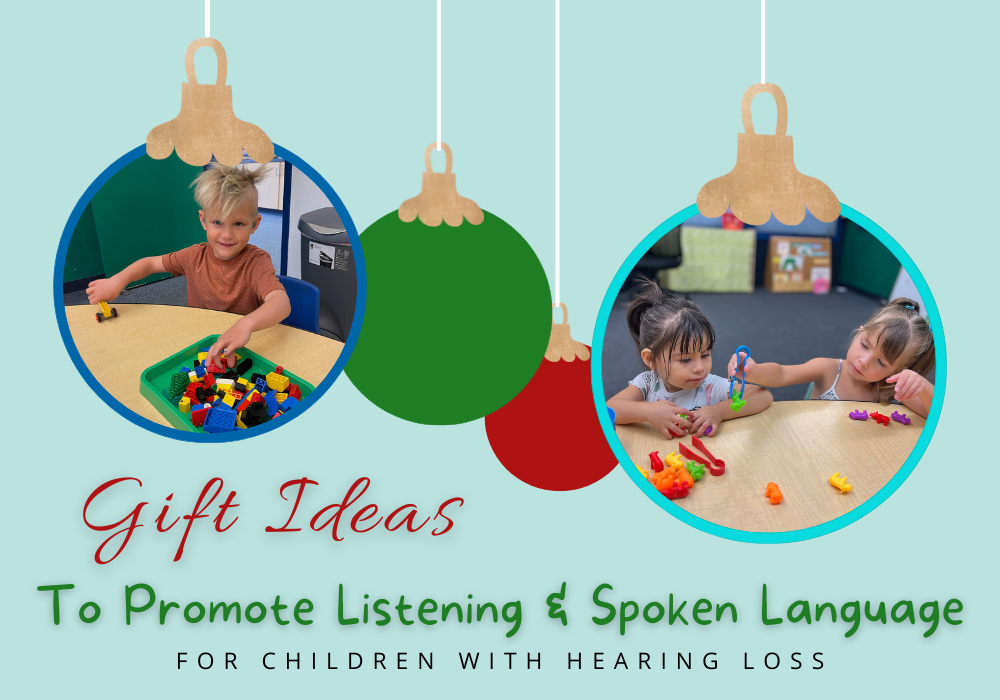Gift Ideas to Promote Listening and Spoken Language for Children with Hearing Loss

This article was written by Jen Borgatti, mom to CCHAT student Nico.
Leading into winter break, I thought it would be helpful to share a list of the best toys for language development, perfect for infants, toddlers and younger kids with hearing loss. You’ll notice several common themes among these toys – no screens and little music. These toys are designed for you to “make your own fun.” Don’t just plop your child on the floor with one of these toys and walk away. Get down on their level and play with them, talk them through the toys, play make-believe and tell a story.
Little People Farm Set
Farm sets are the perfect toy for children who are deaf and hard of hearing. You can work on many animal sounds. You can talk about prepositions; for example, “the pig is next to the mud” or “the chicken is on top of the eggs.” Another fun activity is to put a farm animal behind the barn door, have the child knock on the door, and then you describe the animal, for example, “this animal is brown with a long mane and eats hay.”
“What’s Inside” Box from Lakeshore
Lakeshore makes AMAZING educational toys! I invite you to visit their website and filter by your child’s age. One of our favorites is the “What’s Inside?” Box. This is a perfect toy for practicing listening and spoken language strategies like auditory sandwich, wait time, auditory first and expectant look. Place your hand inside the box and locate an item. but don’t show it to your child. Describe its appearance (“this bug has spots”) or make the sound that the item makes (“beep beep”) and see if your child can guess before receiving the visual. You can use this box with other small toys to work on a variety of sounds. This is truly a top toy for language development.
Playhouses
A playhouse is a wonderful toy for language development because you can act out real world scenarios. You can talk about what each room is called (“bathroom” or “bedroom”) or action words related to rooms (“sleeping” or “eating”). You can add new people to the playhouse to match your own family. This is a great, well-rounded toy that is perfect for toddlers and young kids. Some even close to store all of the pieces, making cleanup a breeze.
Potato Head
These are classics for a reason! Potato Head is one of the best toys for language development because he is so versatile. You can use him to help your child identify his/her body parts. You can go a step further and use this toy to explain the five senses to your child. It’s fun to add to your collection and allow your child to create a one-of-a-kind Potato!
Baby Dolls
A baby doll play set is not just for girls! Dolls are amongst the best toys for language development because of the pretend play opportunities. Your child can pretend to put the baby to sleep (“Shhhh, the baby is sleeping”). Or you can pretend the baby is crying and ask your child, “What should you do?” You can say that the baby may be hungry and pretend to feed her or that the baby may need a diaper change.
You can also use a baby doll to learn about body parts and work on emotions like happy, sad, tired, or upset. Some baby dolls now even have hearing aids and cochlear implants!
Lego/Duplo Blocks
Children have to use an abundance of creativity while playing with building blocks like Duplo and Lego. Specifically for younger children, you can work on color identification or fine motor skills by stacking the blocks. The people included in the set above can go “up, up, up” or “dowwwwwnnnn” various structures that your child builds. Children can grow with these toys and graduate to more advanced versions.
Highlights Magazine Subscription
Yes, the classic that was around when we were little is still here! Highlights has different levels of magazines to fit certain age levels. “High Five” is for ages 2-6 while the traditional “Highlights” is for ages 6-12. I personally have a subscription to both of these magazines for my two boys. They use them interchangeably. We read the magazine together, play games featured inside, complete craft projects, and complete coloring pages. These magazines also make perfect road trip activities for children. I can’t recommend these enough!
Bingo
Bingo is an amazing way to help build language in our kids. Some sets include multiple varieties of the game, including using pictures, the alphabet, sight words and numbers, making it a great value and one you’ll use for years. You can expand on the game, too, by describing the pictures to your child. For example, instead of just saying “lion,” you could say “this animal roars and has a full mane of hair.” Use the listening and spoken language strategy “Auditory First” and don’t show your child the picture of the lion right away. One thing you’ll notice while at CCHAT is that many of our children’s speech therapists play games during one-on-one speech time. That’s because games are a wonderful language builder!
Join in on the Fun
Your child benefits most when you take a proactive approach to playtime. Incorporating plenty of listening and language opportunities will help children develop their communication skills, all while having fun! These ideas are just a start – there are always ways you can make play both fun and educational for your child with hearing loss.






%20(1).png)







































.png)





